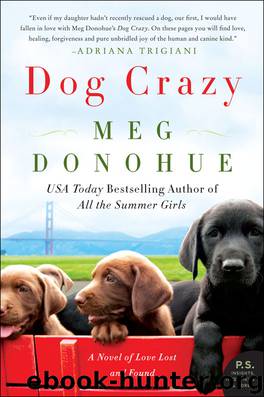Dog Crazy by Meg Donohue

Author:Meg Donohue
Language: eng
Format: epub
Publisher: HarperCollins
Published: 2015-05-21T16:00:00+00:00
Chapter 11
It’s eight o’clock at night, and despite two glasses of wine and the hypnotic crackling of the fire, I still feel shaken by Seymour’s near escape this afternoon—and my own reaction as I watched it unfold. I keep thinking of the pure, animal panic I’d seen in his eyes when he looked at me for a beat of time before spinning around and racing away, and how I’d done nothing to attempt to soothe him. What did he see in my eyes when he looked at me in that moment? Dogs are intuitive enough that he probably didn’t even need to look at me to sense what I was feeling—an opaque sort of anxiety that only reinforced his own fears.
I’ve spent the last hour looking online for information on how to help an anxious dog, and even if I hadn’t already made up my mind about not taking Seymour myself, everything I’ve read is further proof that we would not make a good match. I’m not surprised to learn that people and dogs are pretty similar when it comes to overcoming their phobias.
For fearful, anxious dogs, the ASPCA’s website recommends “systematic desensitization and counterconditioning,” a course of action that is, of course, familiar to me. Desensitization, for a dog who is afraid of city noises and walks like Seymour, would involve taking shorter, quieter walks in less busy areas, slowly building up to more populated streets, avoiding anxiety triggers, and making each walk as pleasant and uneventful as possible.
I think back to my first day of walks with Giselle nearly two weeks earlier, how I’d started with a blink-and-you’d-miss-it walk to the corner and back, taking progressively bolder “baby steps” on each outing. Of course, I haven’t done a very good job of avoiding one of my anxiety triggers—heights—which might explain why I’m still not totally comfortable being outside even though I’ve made considerable headway. But I live in San Francisco now; heights aren’t exactly avoidable. I hope I’m ripping off the Band-Aid—less systematic desensitization than shock exposure therapy.
The counterconditioning part of the ASPCA’s recommendation is something I’ve thought less about when it comes to my own treatment plan. The idea, according to the website, is to retrain, or recondition, the dog’s mind so it associates a once-feared act with something good rather than something bad. With dogs, the best way to do this is using food—if every time a dog goes for a walk on a city street he gets a special treat, over time he will be reconditioned to associate the walk and the noises of the city with feelings of satisfaction and joy.
Maybe I should start hiding wine at the top of these parks Anya keeps taking us to.
Unfortunately, I’m pretty sure alcohol isn’t the healthiest counterconditioning incentive for humans.
As I consider my own walks more, I realize that I do have something that is serving a similar purpose as a special treat would for a dog—helping Anya. Even though she isn’t a patient, experiencing our
Download
This site does not store any files on its server. We only index and link to content provided by other sites. Please contact the content providers to delete copyright contents if any and email us, we'll remove relevant links or contents immediately.
In Control (The City Series) by Crystal Serowka(35354)
The Wolf Sea (The Oathsworn Series, Book 2) by Low Robert(33841)
We Ride Upon Sticks by Quan Barry(33276)
Crowbone (The Oathsworn Series, Book 5) by Low Robert(32318)
The Book of Dreams (Saxon Series) by Severin Tim(32231)
The Daughters of Foxcote Manor by Eve Chase(22282)
Trainspotting by Irvine Welsh(20042)
Call Me by Your Name by André Aciman(18951)
Shot Through The Heart (Supernature Book 1) by Edwin James(17923)
The Secret History by Donna Tartt(16606)
The Girl from the Opera House by Nancy Carson(14982)
Sad Girls by Lang Leav(13344)
American King (New Camelot #3) by Sierra Simone(12980)
Pimp by Iceberg Slim(12922)
All the Missing Girls by Megan Miranda(12739)
The Betrayed by Graham Heather(11689)
The Betrayed by David Hosp(11662)
4 3 2 1: A Novel by Paul Auster(11032)
Still Me by Jojo Moyes(9895)
